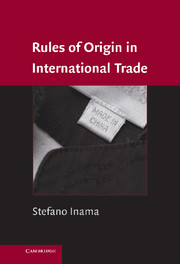Book contents
- Frontmatter
- Contents
- List of Figures
- List of Tables
- List of Acronyms
- Preface
- 1 Efforts to Establish Multilateral Rules
- 2 The Uruguay Round Agreement on Rules of Origin: The Harmonization Work Program of Nonpreferential Rules of Origin
- 3 Preferential Rules of Origin
- 4 The Economics of Rules of Origin
- 5 Drafting Preferential Rules of Origin
- 6 The Administration of Rules of Origin
- Index
3 - Preferential Rules of Origin
Published online by Cambridge University Press: 18 August 2009
- Frontmatter
- Contents
- List of Figures
- List of Tables
- List of Acronyms
- Preface
- 1 Efforts to Establish Multilateral Rules
- 2 The Uruguay Round Agreement on Rules of Origin: The Harmonization Work Program of Nonpreferential Rules of Origin
- 3 Preferential Rules of Origin
- 4 The Economics of Rules of Origin
- 5 Drafting Preferential Rules of Origin
- 6 The Administration of Rules of Origin
- Index
Summary
Until the beginning of the 1990s, there were only a few preferential rules of origin, mainly regulating some autonomous tariff preferential like the Generalized System of Preferences (GSP) schemes. Only the European Community (EC), because of the free-trade areas (FTAs) network with the remaining European Free-Trade Area (EFTA) countries had developed a comprehensive policy on rules of origin.
In the years that followed, and especially after the U.S.–Canada FTA and later North American Free-Trade Agreement (NAFTA) were concluded, rules of origin proliferated. This proliferation follows the path of the flourishing of regional trade agreements (RTAs). In fact, every time that RTAs are entered into, rules of origin have to be part of the agreement.
This chapter deals with (i) unilateral rules of origin contained under autonomous trade regimes like the GSP schemes and other unilateral preferences like the African Growth and Opportunity Act (AGOA) and (ii) contractual rules of origin contained in FTAs like NAFTA and those concluded by the EC with a variety of partners including their respective evolution.
As examined earlier, there are no binding multilateral rules on preferential rules of origin, nor are there efforts to harmonize them. It follows that not only are there different rules of origin in the case of the GSP schemes but, because a number of RTAs have been concluded between developed countries and also increasingly among developed and developing countries and among developing countries, there is an increased diversification of the content and nature of preferential rules of origin.
- Type
- Chapter
- Information
- Rules of Origin in International Trade , pp. 174 - 336Publisher: Cambridge University PressPrint publication year: 2009



